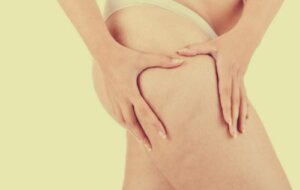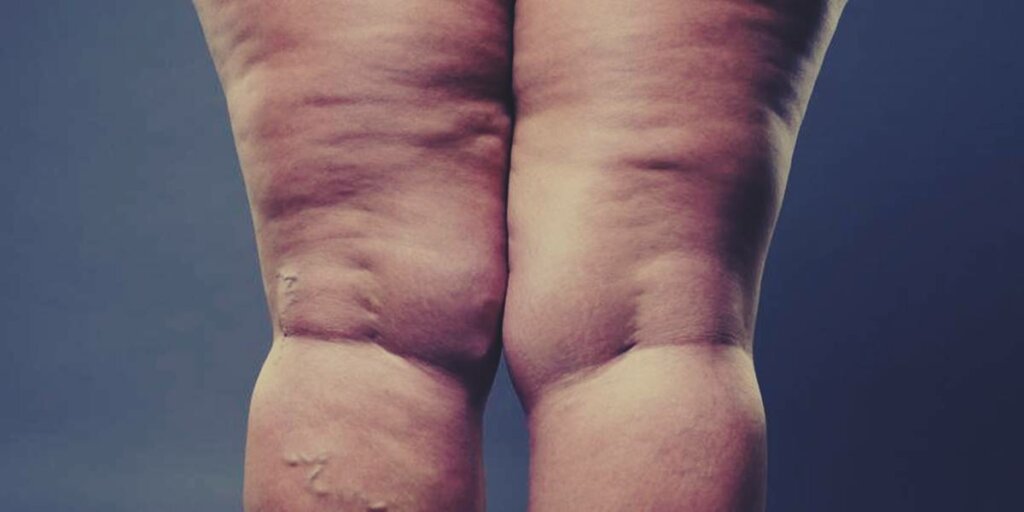Lipedema: Beyond Obesity

Although many confuse the two, lipedema isn’t synonymous with obesity. But, today, there are many women who believe they’re overweight when they see an unusual volume of fat in the area of their hips and thighs. Lipedema is an accumulation of excessive fat that can’t be reduced with rigorous diets or hard training sessions.
The World Health Organization (WHO) estimates that between ten and eleven percent of women suffer from this disease. However, many have never been diagnosed while others suffer in silence from this chronic, limiting, and often painful condition. Moreover, it affects the sufferer’s self-esteem and quality of life due to the fact that they’re having to deal with an ailment with numerous physical effects.
Some of the female population suffering from this problem will avoid going to the doctor, believing that it’s due to them being overweight. But, in reality, it’s not caused by diet nor is it something they can avoid or prevent by improving their lifestyles.
Women with lipedema feel as if they have two bodies. One apparently normal (upper body) area and another disproportionately disproportionate body from the waist down.

Lipedema
Lipedema is a disease that causes inflammation of the fat cells of the hips and thighs. It’s important not to confuse it with lymphedema (swelling of arms or legs). Those who suffer from lipedema experience an unusual accumulation of fat below the waist.
For example, it’s common to see thin women with abnormally thick legs and abundant cellulite. Moreover, these excessive fat deposits in the legs, thighs, and buttocks cause them pain and a noticeable feeling of heaviness.
A study conducted by the University of Lausanne (Switzerland) states that lipedema is a chronic and progressive disease. It begins around adolescence and gradually increases as the years go by.
This abnormal distribution of fat is associated with pain in the extremities. Most importantly, it’s accompanied by considerable disability. Indeed, it affects the sufferer’s daily functioning and they experience extreme psychosocial distress.
The symptoms
As a rule, lipedema presents with varied symptoms. It often begins in adolescence after the commencement of menstruation. This is when the sufferer’s body starts to develop disproportionately. Gradually, excess fat accumulates on their thighs, buttocks, and legs.
It might also appear after a first pregnancy or even during menopause. In fact, the hormonal factor is decisive in the appearance of this disorder.
Heaviness and pain
Lipedema is accompanied by a pronounced feeling of heaviness as well as debilitating inflammation. The woman gradually feels more clumsy, her mobility changes, and it’s not easy for her to find relief from the pain.
While obesity manifests itself in a general increase in volume that’s not painful, lipedema causes discomfort. This is especially intense in the calves.
Women suffering from lipedema experience pain just by touching their legs. The subcutaneous tissue is hard to the touch, unlike the classic accumulation of fat.
The appearance of Cuff Cup
Cuff cup is a characteristic abnormality of lipedema. It appears when fat noticeably accumulates above the ankles.
Itching and bruising
Due to inflammation and obvious circulation problems, it’s common for sufferers to experience sudden itching in the leg area, as well as noticeable bruising and discoloration of the skin.
- It’s also common for them to experience telangiectasias (spider veins) in the thigh area.
Physical and psychosocial changes
Lipedema completely alters the quality of life of the sufferer. They lose mobility, suffer when they have to bend their knees, and see their social and work lives as extremely restricted. Not to mention the impact on their self-esteem.
The cause of lipedema
Research conducted by the University of Wurzburg (Germany) indicates that the pathophysiology of lipedema remains unknown. In fact, there are no clear biomarkers and no thyroid-related triggers have been observed.
However, the following hypothesis is maintained:
- There may be a change in intestinal permeability that occurs with increased inflammation in the intestinal microbiota.
- This triggers a large number of cytokines (proteins that cause an inflammatory response from the immune system) to reach the bloodstream.
- This response causes the fat cells in the legs to increase their size up to ten times.
- The body reacts by producing even more fat cells. Over time, this process becomes chronic.

Treatment for lipedema
Most importantly, the sufferer needs a proper diagnosis. That’s because, often, women subject themselves to rigorous diets without seeing any results. This leads them to frustrating and exhausting psychological states.
However, when they’re informed that, in this disease, diet and sports don’t change anything, they feel relief. Treatment is as follows:
- Pain reduction. For example, drugs, compression stockings, and water therapy.
- Surgical intervention. Decompression liposuction assisted by WAL (water-assisted liposuction) is the only effective technique for treating lipedema.
Finally, it’s important to raise awareness of lipedema so that the ten percent of women who suffer from this disorder in silence are aware of its origin and existing treatments. Indeed, liposuction completely eliminates fat cells, as well as stem cells and the patient’s quality of life is completely improved. Furthermore, the pain disappears and their legs return to normal size.
Although many confuse the two, lipedema isn’t synonymous with obesity. But, today, there are many women who believe they’re overweight when they see an unusual volume of fat in the area of their hips and thighs. Lipedema is an accumulation of excessive fat that can’t be reduced with rigorous diets or hard training sessions.
The World Health Organization (WHO) estimates that between ten and eleven percent of women suffer from this disease. However, many have never been diagnosed while others suffer in silence from this chronic, limiting, and often painful condition. Moreover, it affects the sufferer’s self-esteem and quality of life due to the fact that they’re having to deal with an ailment with numerous physical effects.
Some of the female population suffering from this problem will avoid going to the doctor, believing that it’s due to them being overweight. But, in reality, it’s not caused by diet nor is it something they can avoid or prevent by improving their lifestyles.
Women with lipedema feel as if they have two bodies. One apparently normal (upper body) area and another disproportionately disproportionate body from the waist down.

Lipedema
Lipedema is a disease that causes inflammation of the fat cells of the hips and thighs. It’s important not to confuse it with lymphedema (swelling of arms or legs). Those who suffer from lipedema experience an unusual accumulation of fat below the waist.
For example, it’s common to see thin women with abnormally thick legs and abundant cellulite. Moreover, these excessive fat deposits in the legs, thighs, and buttocks cause them pain and a noticeable feeling of heaviness.
A study conducted by the University of Lausanne (Switzerland) states that lipedema is a chronic and progressive disease. It begins around adolescence and gradually increases as the years go by.
This abnormal distribution of fat is associated with pain in the extremities. Most importantly, it’s accompanied by considerable disability. Indeed, it affects the sufferer’s daily functioning and they experience extreme psychosocial distress.
The symptoms
As a rule, lipedema presents with varied symptoms. It often begins in adolescence after the commencement of menstruation. This is when the sufferer’s body starts to develop disproportionately. Gradually, excess fat accumulates on their thighs, buttocks, and legs.
It might also appear after a first pregnancy or even during menopause. In fact, the hormonal factor is decisive in the appearance of this disorder.
Heaviness and pain
Lipedema is accompanied by a pronounced feeling of heaviness as well as debilitating inflammation. The woman gradually feels more clumsy, her mobility changes, and it’s not easy for her to find relief from the pain.
While obesity manifests itself in a general increase in volume that’s not painful, lipedema causes discomfort. This is especially intense in the calves.
Women suffering from lipedema experience pain just by touching their legs. The subcutaneous tissue is hard to the touch, unlike the classic accumulation of fat.
The appearance of Cuff Cup
Cuff cup is a characteristic abnormality of lipedema. It appears when fat noticeably accumulates above the ankles.
Itching and bruising
Due to inflammation and obvious circulation problems, it’s common for sufferers to experience sudden itching in the leg area, as well as noticeable bruising and discoloration of the skin.
- It’s also common for them to experience telangiectasias (spider veins) in the thigh area.
Physical and psychosocial changes
Lipedema completely alters the quality of life of the sufferer. They lose mobility, suffer when they have to bend their knees, and see their social and work lives as extremely restricted. Not to mention the impact on their self-esteem.
The cause of lipedema
Research conducted by the University of Wurzburg (Germany) indicates that the pathophysiology of lipedema remains unknown. In fact, there are no clear biomarkers and no thyroid-related triggers have been observed.
However, the following hypothesis is maintained:
- There may be a change in intestinal permeability that occurs with increased inflammation in the intestinal microbiota.
- This triggers a large number of cytokines (proteins that cause an inflammatory response from the immune system) to reach the bloodstream.
- This response causes the fat cells in the legs to increase their size up to ten times.
- The body reacts by producing even more fat cells. Over time, this process becomes chronic.

Treatment for lipedema
Most importantly, the sufferer needs a proper diagnosis. That’s because, often, women subject themselves to rigorous diets without seeing any results. This leads them to frustrating and exhausting psychological states.
However, when they’re informed that, in this disease, diet and sports don’t change anything, they feel relief. Treatment is as follows:
- Pain reduction. For example, drugs, compression stockings, and water therapy.
- Surgical intervention. Decompression liposuction assisted by WAL (water-assisted liposuction) is the only effective technique for treating lipedema.
Finally, it’s important to raise awareness of lipedema so that the ten percent of women who suffer from this disorder in silence are aware of its origin and existing treatments. Indeed, liposuction completely eliminates fat cells, as well as stem cells and the patient’s quality of life is completely improved. Furthermore, the pain disappears and their legs return to normal size.
All cited sources were thoroughly reviewed by our team to ensure their quality, reliability, currency, and validity. The bibliography of this article was considered reliable and of academic or scientific accuracy.
- Buso, G., Depairon, M., Tomson, D., Raffoul, W., Vettor, R., & Mazzolai, L. (2019). Lipedema: A Call to Action!. Obesity (Silver Spring, Md.), 27(10), 1567–1576. https://www.ncbi.nlm.nih.gov/pmc/articles/PMC6790573/
-
Canning, C., & Bartholomew, J. R. (2018). Lipedema. Vascular medicine, 23(1), 88–90. https://pubmed.ncbi.nlm.nih.gov/29143577/
- Czerwińska, M., Ostrowska, P., & Hansdorfer-Korzon, R. (2021). Lipoedema as a Social Problem. A Scoping Review. International journal of environmental research and public health, 18(19), 10223. https://www.ncbi.nlm.nih.gov/pmc/articles/PMC8508106/
- Kruppa, P., Georgiou, I., Biermann, N., Prantl, L., Klein-Weigel, P., & Ghods, M. (2020). Lipedema-Pathogenesis, Diagnosis, and Treatment Options. Deutsches Arzteblatt international, 117(22-23), 396–403. https://www.ncbi.nlm.nih.gov/pmc/articles/PMC7465366/
-
Peprah, K., & MacDougall, D. (2019). Liposuction for the Treatment of Lipedema: A Review of Clinical Effectiveness and Guidelines. Canadian Agency for Drugs and Technologies in Health. https://www.ncbi.nlm.nih.gov/books/NBK545818/
- Pereira, N. (2021). Lipedema: más que un problema de “piernas gordas”. Actualización en la fisiopatología, diagnóstico y tratamiento quirúrgico. Revista de cirugía, 73(3), 370-377. https://www.scielo.cl/scielo.php?script=sci_arttext&pid=S2452-45492021000300370
- Quirós Siniterra de Vásquez , L. ., & Uclés Villalobos , V. (2022). Lipedema: lo que debemos conocer. Revista De La Facultad De Medicina De La Universidad De lberoamérica, 1(1). https://www.unibe.ac.cr/ojs/index.php/RFMUI/article/view/113
- Torre, Y., Wadeea, R., Rosas, V. & Herbst, K. (2018). Lipedema: friend and foe. Hormone Molecular Biology and Clinical Investigation, 33(1), 20170076. https://www.degruyter.com/document/doi/10.1515/hmbci-2017-0076/html#APA
- Szél, E., Kemény, L., Groma, G., & Szolnoky, G. (2014). Pathophysiological dilemmas of lipedema. Medical hypotheses, 83(5), 599–606. https://pubmed.ncbi.nlm.nih.gov/25200646
This text is provided for informational purposes only and does not replace consultation with a professional. If in doubt, consult your specialist.







